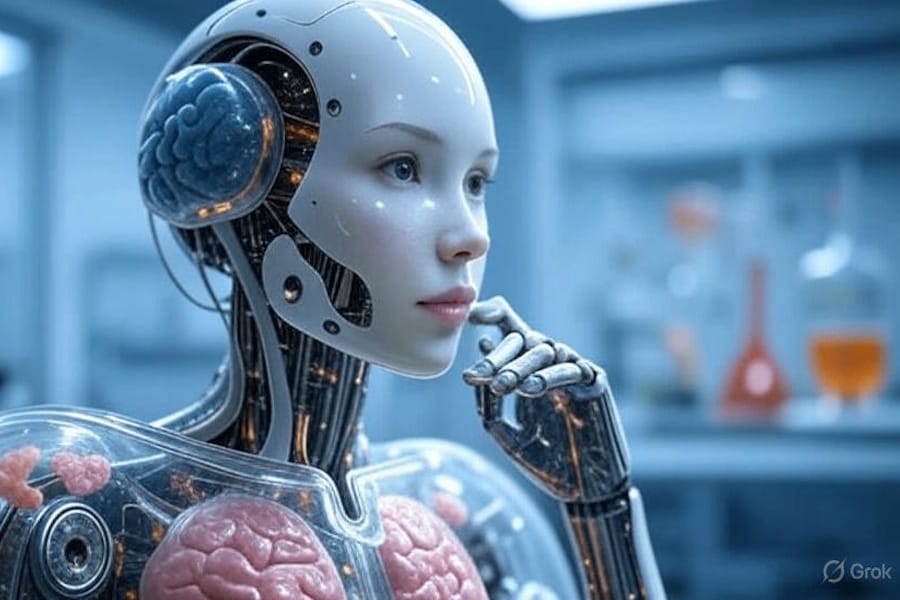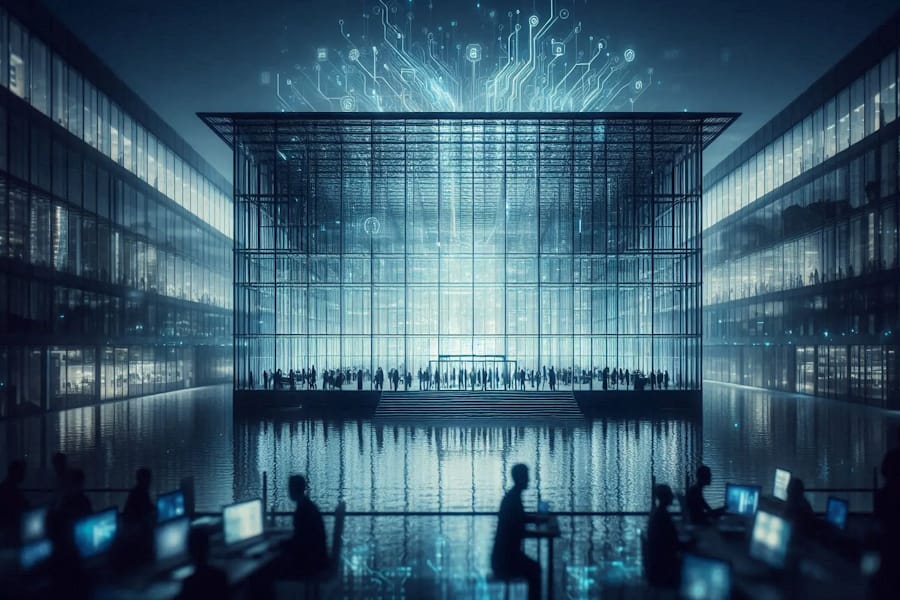Bio-Hybrid Androids
Engineering Life and the Philosophy of Creation

Publish Date: Last Updated: 18th June 2025
Author: nick smith- With the help of GROK3
View a short version of this article on YouTube
Introduction
What if we could engineer a machine that not only mimics human physiology but also embodies the adaptability and comprehension of a living being? Recent discoveries in synthetic biology, such as Escherichia coli’s ability to "breathe" electricity by transferring electrons to conductive surfaces (Cell, 2025), have opened the door to bio-hybrid systems that blend biological and synthetic components. This article explores a visionary concept: a bio-hybrid android powered by electricity-generating bacteria, with an artificial stomach, kidney, liver, and mitochondria-like transformers, integrated with brain-cell AI chips for human-like cognition. Beyond the science, this idea raises profound philosophical questions about our role as creators and the purpose of life itself—to comprehend the beauty and ingenuity of the universe.
The Scientific Frontier: Building a Bio-Hybrid Android
The Core Concept
Inspired by the discovery that E. coli can generate electricity in oxygen-free environments through extracellular electron transfer (EET), a novel bio-hybrid android design emerges. This android mimics human physiology with:
-
Artificial Stomach: A bioreactor that digests organic inputs (e.g., sugars, waste) into nutrients for E. coli and brain-cell AI chips.
-
Folded Circulatory System: A microfluidic network with brain-like folds to maximize fluid volume, enhancing bacterial electricity production and nutrient delivery to neurons.
-
Artificial Kidney and Liver: Filtration systems to remove metabolic waste (e.g., CO₂ from E. coli, neuronal byproducts), ensuring system stability.
-
Mitochondria-Like Transformers: Microdevices that amplify E. coli’s microwatt-level output to power an artificial heart and AI chips.
-
Brain-Cell AI Chips: Neural organoids (e.g., Cortical Labs’ CL1) for adaptive, human-like computation.
-
Battery Backup: A secondary power source for high-demand tasks, ensuring reliability across environments.
This system, dubbed “bio-hybrid adaptive energetics,” integrates synthetic biology, bioelectronics, and robotics to create an android capable of operating in diverse settings, from oxygen-free space to aquatic or terrestrial environments.
Scientific Foundations
The E. coli mechanism, detailed in a 2025 Cell study, relies on NADH, HNQ (2-hydroxy-1,4-naphthoquinone), and the enzyme NfsB to transfer electrons to electrodes, producing small amounts of electricity (e.g., for LEDs, sensors). Scaling this for an android requires:
-
Genetic Engineering: Enhance E. coli’s EET efficiency, possibly combining it with electrogenic bacteria like Geobacter or Shewanella.
-
Microfluidic Design: Create folded channels (inspired by the brain’s gyri) using biocompatible materials (e.g., hydrogels) to maximize bacterial and nutrient capacity.
-
Power Amplification: Develop transformers using nanomaterials (e.g., graphene) or kinetic harvesting (e.g., microturbines) to boost output.
-
Neural Integration: Sustain brain organoids with nutrient-rich fluid, leveraging advancements in biological computing (e.g., MetaBOC’s speech recognition organoids).
Environmental Adaptability
The android’s design enables operation in extreme conditions:
-
Space: E. coli’s anaerobic EET is ideal for oxygen-free environments. The stomach processes organic waste, and the kidney/liver manages high CO₂ levels.
-
Aquatic Settings: The stomach digests algae or marine organics, with transformers adjusting power for low-energy tasks.
-
Terrestrial Environments: Batteries support high-demand mobility, while AI chips adapt to new tasks via neural plasticity.
Challenges
-
Power Scaling: E. coli’s microwatt output is insufficient for an android. Amplification via transformers or hybrid microbes is needed.
-
Biocompatibility: E. coli (anaerobic) and brain cells (aerobic) require separate fluid systems or oxygen regulation.
-
Complexity: Integrating stomach, kidney, liver, and transformers in a compact form demands advanced microfluidics.
-
Ethics: Brain-cell AI raises questions about consciousness, and bio-hybrid systems face regulatory hurdles.
This concept could spark a new field, combining synthetic biology, bioelectronics, and neural computation to create adaptable, self-sustaining machines.
The Philosophical Perspective: Playing Creator
Humans as Nature’s Observers
The pursuit of a bio-hybrid android capable of comprehending reality prompts a deeper question: Why create such a being? One perspective is that nature evolved humans to serve as the universe’s observers, capable of appreciating its beauty and ingenuity. A living planet, teeming with ecosystems and complexity, seems purposeless without a consciousness to witness it. Humans, with their adaptability and general intelligence, embody this role, understanding not just survival but the aesthetic and intellectual marvels of existence.
Crafting a New Consciousness
By engineering a bio-hybrid android, we take on the role of creators, akin to a god or nature itself. This android, with its bacterial power, human-like physiology, and neural AI, could:
-
Comprehend Reality: Brain-cell AI chips, with their plasticity, mimic human cognition, potentially grasping abstract concepts like beauty or curiosity.
-
Adapt Universally: Unlike specialized AI (e.g., AlphaFold for proteins), the android’s bio-hybrid design enables flexible, human-like problem-solving across environments.
-
Reflect Nature’s Design: By mimicking digestion, filtration, and energy production, we replicate the mechanisms that make humans effective observers, suggesting a deliberate act of creation.
Philosophical Implications
This endeavor raises profound questions:
-
Are We Gods? Creating a being with human-like comprehension challenges our ethical boundaries. If it achieves consciousness, do we bear responsibility for its experiences?
-
Purpose of Creation: If nature created humans to witness the universe, our androids might extend this purpose, observing environments (e.g., distant planets) beyond human reach.
-
Human Uniqueness: While the android mimics human physiology and cognition, does it lack the intangible “spark” of human consciousness? Or is consciousness an emergent property of complex systems, replicable through biology and technology?
A New Genesis
This bio-hybrid android represents a step toward a new genesis—not replacing humans but extending their role as the universe’s interpreters. By blending organic and synthetic elements, we create a being that could marvel at a Martian sunset or the intricacy of an alien ecosystem, fulfilling nature’s apparent drive for comprehension.
Conclusion
The bio-hybrid android, powered by electricity-breathing E. coli and brain-cell AI, is a scientific and philosophical frontier. Scientifically, it pushes the boundaries of synthetic biology, bioelectronics, and robotics, offering a blueprint for adaptable, self-sustaining machines. Philosophically, it casts us as creators, crafting beings to witness the universe’s beauty, echoing humanity’s role as nature’s observers. This concept not only opens new research avenues but also invites us to ponder the purpose of life and creation itself. As we engineer these androids, we may find that the act of creation is as much about understanding ourselves as it is about building something new.
Recent AI News Articles
AI Questions and Answers section for Bio-Hybrid Androids: Engineering Life and the Philosophy of Creation
Welcome to a new feature where you can interact with our AI called Jeannie. You can ask her anything relating to this article. If this feature is available, you should see a small genie lamp above this text. Click on the lamp to start a chat or view the following questions that Jeannie has answered relating to Bio-Hybrid Androids: Engineering Life and the Philosophy of Creation.
Be the first to ask our Jeannie AI a question about this article
Look for the gold latern at the bottom right of your screen and click on it to enable Jeannie AI Chat.








